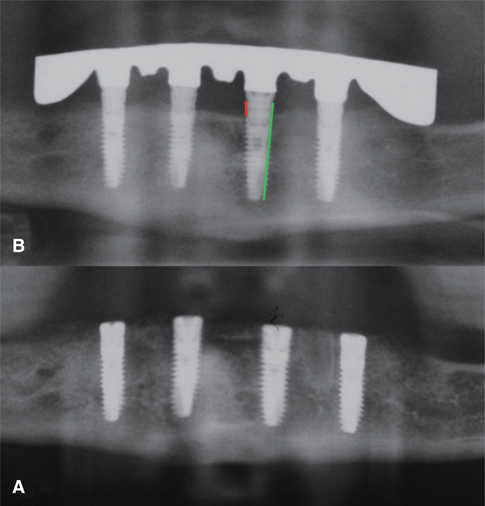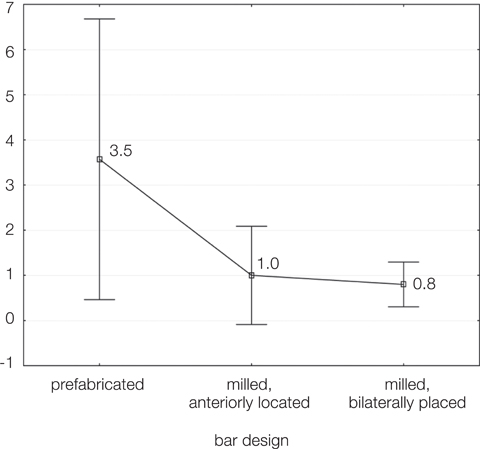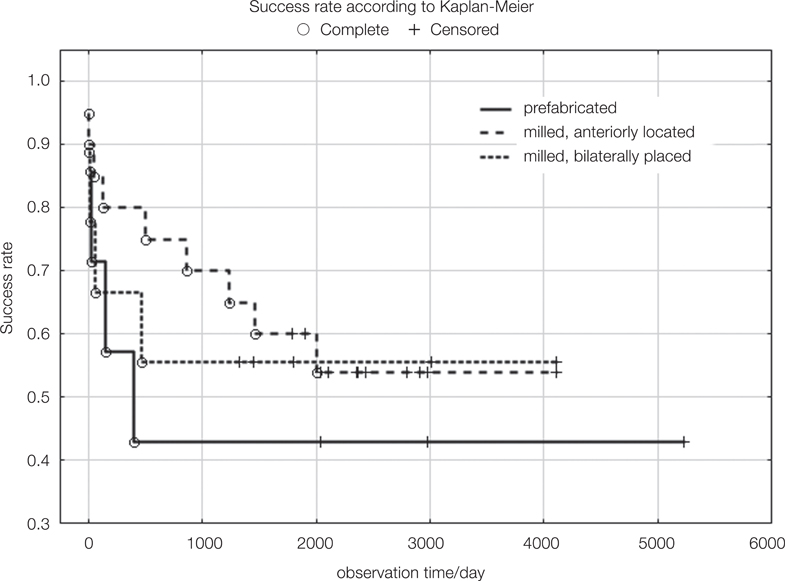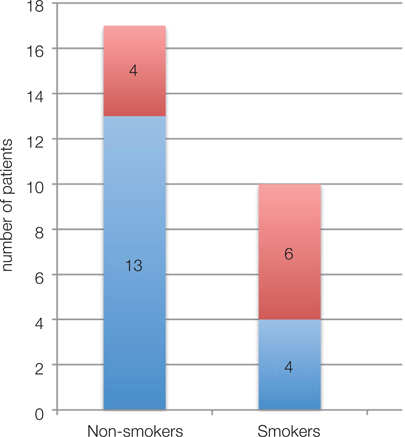J Adv Prosthodont.
2015 Aug;7(4):338-343. 10.4047/jap.2015.7.4.338.
Implant-supported overdentures with different bar designs: A retrospective evaluation after 5-19 years of clinical function
- Affiliations
-
- 1Department of Prosthodontics, Georg-August-University, Goettingen, Germany. matthias.roediger@med.uni-goettingen.de
- 2Private Practice, Hanau, Germany.
- KMID: 2118271
- DOI: http://doi.org/10.4047/jap.2015.7.4.338
Abstract
- PURPOSE
This retrospective study evaluated the outcome of implant-retained overdentures (IODs) after 5-19 years of clinical function.
MATERIALS AND METHODS
A retrospective analysis of patient files was performed referring to 27 patients who received 36 IODs with 3 different bar designs (group A=prefabricated round bars, n=7; group B=one-piece anterior milled bars, n=20; and group C=two bilaterally placed milled bars, n=9) in the mandible (n=24) and/or in the maxilla (n=12). The analysis focused on the survival and success rates (according to Kaplan-Meier) of the implants and prostheses. Technical complication rates for each type of restoration were analyzed and compared via one-way ANOVA and the Chi-squared test. The prevalence of peri-implantitis (radiographic bone loss > or =3.5 mm) was evaluated by digital analysis of panoramic radiographs taken post-operative (baseline) and after 5-19 years of clinical function (follow-up).
RESULTS
The mean observational time was 7.3 years. The survival rates of the prostheses and implants were 100% and 97.7%, respectively. Technical complications occurred more frequently in group A (mean: 3.5 during observational time) than in the other two groups (B: 0.8; C: 1.0). However, this difference was not statistically significant (P=0.58). Peri-implantitis was diagnosed for 12.4% of the implants in 37% of the patients.
CONCLUSION
Bar-retained IODs are an adequate treatment option for edentulous jaws. These restorations may exhibit high implant/prosthesis survival rates (>97%), and a limited incidence of technical complications after a mean observational period of >7 years. Nevertheless, peri-implantitis was identified as a frequent and serious biological complication for this type of reconstruction.
MeSH Terms
Figure
Cited by 1 articles
-
Precision of the milled full-arch framework fabricated using pre-sintered soft alloy: A pilot study
Hyun-Wook Woo, Sung-Am Cho, Cheong-Hee Lee, Kyu-Bok Lee, Jin-Hyun Cho, Du-Hyeong Lee
J Adv Prosthodont. 2018;10(2):128-131. doi: 10.4047/jap.2018.10.2.128.
Reference
-
1. Krennmair G, Krainhöfner M, Piehslinger E. The influence of bar design (round versus milled bar) on prosthodontic maintenance of mandibular overdentures supported by 4 implants: a 5-year prospective study. Int J Prosthodont. 2008; 21:514–520.2. Krennmair G, Piehslinger E. Removable implant-supported maxillary prostheses anchored on milled bars: a retrospective evaluation of two concepts. Int J Prosthodont. 2009; 22:576–578.3. Andreiotelli M, Att W, Strub JR. Prosthodontic complications with implant overdentures: a systematic literature review. Int J Prosthodont. 2010; 23:195–203.4. Brosky ME, Korioth TW, Hodges J. The anterior cantilever in the implant-supported screw-retained mandibular prosthesis. J Prosthet Dent. 2003; 89:244–249.5. Krennmair G, Krainhöfner M, Piehslinger E. Implant-supported mandibular overdentures retained with a milled bar: a retrospective study. Int J Oral Maxillofac Implants. 2007; 22:987–994.6. Krennmair G, Sütö D, Seemann R, Piehslinger E. Removable four implant-supported mandibular overdentures rigidly retained with telescopic crowns or milled bars: a 3-year prospective study. Clin Oral Implants Res. 2012; 23:481–488.7. Meijer HJ, Raghoebar GM, Batenburg RH, Visser A, Vissink A. Mandibular overdentures supported by two or four endosseous implants: a 10-year clinical trial. Clin Oral Implants Res. 2009; 20:722–728.8. Ueda T, Kremer U, Katsoulis J, Mericske-Stern R. Long-term results of mandibular implants supporting an overdenture: implant survival, failures, and crestal bone level changes. Int J Oral Maxillofac Implants. 2011; 26:365–372.9. Rinke S, Roediger M, Eickholz P, Lange K, Ziebolz D. Technical and biological complications of single-molar implant restorations. Clin Oral Implants Res. 2015; 26:1024–1030.10. Frisch E, Ziebolz D, Ratka-Krüger P, Rinke S. Double crown-retained maxillary overdentures: 5-year follow-up. Clin Implant Dent Relat Res. 2015; 17:22–31.11. Abd El-Dayem MA, Assad AS, Eldin Sanad ME, Mahmoud Mogahed SA. Comparison of prefabricated and custommade bars used for implant-retained mandibular complete overdentures. Implant Dent. 2009; 18:501–511.12. Cehreli MC, Karasoy D, Kökat AM, Akça K, Eckert S. A systematic review of marginal bone loss around implants retaining or supporting overdentures. Int J Oral Maxillofac Implants. 2010; 25:266–277.13. Rinke S, Ohl S, Ziebolz D, Lange K, Eickholz P. Prevalence of periimplant disease in partially edentulous patients: a practice-based cross-sectional study. Clin Oral Implants Res. 2011; 22:826–833.14. Bressan E, Tomasi C, Stellini E, Sivolella S, Favero G, Berglundh T. Implant-supported mandibular overdentures: a cross-sectional study. Clin Oral Implants Res. 2012; 23:814–819.15. Heschl A, Payer M, Clar V, Stopper M, Wegscheider W, Lorenzoni M. Overdentures in the edentulous mandible supported by implants and retained by a Dolder bar: a 5-year prospective study. Clin Implant Dent Relat Res. 2013; 15:589–599.
- Full Text Links
- Actions
-
Cited
- CITED
-
- Close
- Share
- Similar articles
-
- Detachable zirconia prosthesis using Milled bar and ADDTOC attachment in partial edentulous mandible: A case report
- Implant and root supported overdentures - a literature review and some data on bone loss in edentulous jaws
- Implant-supported milled bar overdenture with two implant surgical guides
- Effects Of Overdenture Retention On The Axial Load Of Implant In The Mandibular Implant-Supported Overdenture
- Rehabilitation of edentulous maxilla with implant-supported milled bar overdenture using CAD/CAM customized abutment: A case report





